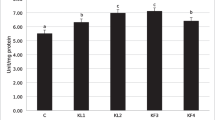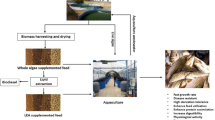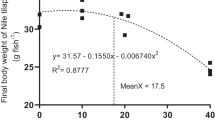Abstract
Two 40-day feeding trials using extruded diets were conducted to assess the effect of a dietary phospholipid (PL) supplementation on growth, survival and fatty acid composition of European sea bass (Dicentrarchus labrax) and turbot (Scophthalmus maximus) from weaning onwards. Two dietary treatments (FO and PL) were tested; both had an identical extruded basis (92.5% total diet weight) coated with a different lipid fraction (7.5% total diet weight). Diet PL contained 2% egg yolk PL (69% pure). In diet FO the PL was replaced by hydrogenated coconut oil. The isolipidic diets contained an equal amount of fish oil ethyl esters providing 1.6% (% diet dry weight) of n-3 highly unsaturated fatty acids (HUFA). A diet water stability test showed no effect of the PL supplementation on the leaching of the dietary fatty acids. In both fish species weight, but not survival, significantly increased as a result of PL supplementation. Weaning onto the experimental diets resulted in similar changes in the relative percent levels of fatty acids in both species. In general, the percentage of saturated fatty acids levelled off after a rapid increase, while monoenes increased after an initial decrease. Total n-3 polyunsaturated fatty acids (PUFA) decreased and total n-6 PUFA remained almost constant. The major effect of the dietary PL on fish fatty acid composition was a 50% increase in n-6 and n-3 HUFAs compared to the PL-free FO diet. The rise in n-6 HUFA may have reflected the higher moiety in the dietary PL. On the other hand this was not the case for the n-3 HUFA since they represented only low levels in the PL fraction (0.1%) compared to that provided by the ethyl esters (1.6%) suggesting a more efficient incorporation of the PL n-3 HUFA than of the ethyl ester n-3 HUFA. A second hypothesis is that the dietary PL may have favored the incorporation of the dietary ethyl ester n-3 HUFA.
Similar content being viewed by others
References cited
Bell, J.G., Castell, J.D., Tocher, D.R., MacDonald, F.M. and Sargent, J.R. 1995. Effects of different dietary arachidonic: docosahexaenoic ratios on phospholipid fatty acid compositions and prostaglandin production in juvenile turbot (Scophthalmus maximus). Fish Physiol. Biochem. 14: 139-151.
Cahu, C.L. and Zambonino Infante, J. 1994. Early weaning of sea bass (Dicentrarchus labrax) larvae with a compound diet: effect on digestive enzymes. Comp. Biochem. Physiol. 109A: 213-222.
Castell, J.D., Bell, J.G., Tocher, D.R. and Sargent, J.R. 1994. Effects of purified diets containing different combinations of arachidonic and docosahexaenoic acid on survival, growth and fatty acid composition of juvenile turbot (Scophthalmus maximus). Aquaculture 128: 315-333.
Charlon, N. and Bergot, P. 1986. An improved automatic dry food dispenser for fish larvae. Prog. Fish Cult. 48: 156-158.
Coutteau, P. and Sorgeloos, P. 1995. Intercalibration exercise on the qualitative and quantitative analysis of fatty acids in Artemia and marine samples. ICES Cooperative Research Report 211: 1-30.
Coutteau, P., Geurden, I., Schwarz, L. and Sorgeloos, P. 1995a. A combined salinity/countercurrent stress test to evaluate stress sensitivity of juvenile European sea bass Dicentrarchus labrax. Eur. Aquacult. Soc. 23: 29-30.
Coutteau, P., Van Stappen, G. and Sorgeloos, P. 1995b. A standard experimental diet for the study of fatty acid requirements of weaning and first ongrowing stages of European sea bass (Dicentrarchus labrax L.): selection of the basal diet. ICES Mar. Sci. Symp. 201: 130-137.
Coutteau, P., Geurden, I., Camara, M.R., Bergot, P. and Sorgeloos, P. 1997. Review on the dietary effects of phospholipids in fish and crustacean larviculture. Aquaculture (In press).
Coutteau, P., Van Stappen, G. and Sorgeloos, P. 1996. A standard experimental diet for the study of fatty acid requirements of weaning and first ongrowing stages of marine fish: a comparison of extruded and extruded/coated diets. Arch. Anim. Nutr. 49: 49-59.
Dhert, P., Lavens, P., Duray, M. and Sorgeloos, P. 1990. Improved larval survival at metamorphosis of Asian sea bass (Lates calcarifer) using n-3-HUFA-enriched live food. Aquaculture 90: 63-74.
Folch, J., Lees, M. and Stanley, G.S. 1957. A simple method for the isolation and purification of total lipids from animal tissues. J. Biol. Chem. 226: 497-509.
Fraser, A.J., Sargent, J.R., Gamble, J.C. and MacLachlan, P. 1987. Lipid class and fatty acid composition as indicators of the nutritional condition of larval Atlantic herring. Am. Fish. Soc. Symp. 2: 129-143.
Geurden, I., Radünz-Neto, J. and Bergot, P. 1995. Essentiality of dietary phospholipids for carp (Cyprinus carpio L.) larvae. Aquaculture 131: 303-314.
Geurden, I., Charlon, N., Marion, D. and Bergot, P. 1997. Influence of purified soybean phospholipids on early development of carp (Cyprinus carpio L.). Aquac. Int. (In press).
Holt, G.J. 1993. Feeding larval red drum on microparticulate diets in a closed recirculating water system. J. World Aquac. Soc. 24: 225-230.
Jones, D.A., Kamarudin, M.S. and Le Vay, L. 1993. The potential of replacement of live feeds in larval culture. J. World Aquac. Soc. 24: 199-210.
Kanazawa, A. 1993. Essential phospholipids of fish and crustaceans. In Fish Nutrition in Practice, pp. 519-530. Edited by S.J. Kaushik and P. Luquet. Ed. INRA, Paris.
Kanazawa, A., Teshima, S., Inamori, S., Iwashita, T. and Nagao, A. 1981. Effects of phospholipids on growth, survival rate and incidence of malformation in the larval ayu. Mem. Fac. Fish. Kagoshima Univ. 30: 301-309.
Kanazawa, A., Teshima, S., Inamori, S. and Matsubara, H. 1983a. Effects of dietary phospholipids on growth of the larval red sea bream and knife jaw. Mem. Fac. Fish. Kagoshima Univ. 32: 109-114.
Kanazawa, A., Teshima, S., Kobayashi, T., Takae, M., Iwashita, T. and Uehara, R. 1983b. Necessity of dietary phospholipids for growth of the larva ayu. Mem. Fac. Fish. Kagoshima Univ. 32: 115-120.
Kanazawa, A., Teshima, S. and Sakomoto, M. 1985. Effects of dietary bonito-egg phospholipids and some phospholipids on growth and survival of the larval ayu, Plecoglossus altivelis. Z. Angew. Ichthyol. 4: 165-170.
Kolkovski, S., Tandler, A. Kissel, G.W. and Gertler, A. 1993. The effect of dietary exogenous enzymes on ingestion, assimilation, growth and survival of gilthead seabream (Sparus aurata Linnaeus, Sparidae) larvae. Fish Physiol. Biochem. 12: 203-209.
Koven, W.M., Kolkovski, S., Tandler, A., Kissil, G.Wm. and Sklan, D. 1993. The effect of dietary lecithin and lipase, as a function of age, on n-9 fatty acid incorporation in the tissue lipids of Sparus aurata larvae. Fish Physiol. Biochem. 10: 357-364.
Léger, Ph., Naessens-Foucqaert, E. and Sorgeloos, P. 1987. International Study on Artemia. XXXV. Techniques to manipulate the fatty acid profile in Artemia nauplii and the effect on its nutritional effectiveness for the marine crustacean Mysidopsis bahia (M.). In Artemia Research and its Applications. Vol. 3, pp. 411-424. Edited by P. Sorgeloos, D.A. Bengtson, W. Decleir and E. Jaspers. Universa Press, Wetteren.
Lepage, G. and Roy, C.C. 1984. Improved recovery of fatty acid trough direct transesterification without prior extraction or purification. J. Lipid Res. 25: 1391-1396.
Linares, F. and Henderson, R.J. 1991. Incorporation of 14 Clabelled polyunsaturated fatty acids by juvenile turbot, Scophthalmus maximus (L.) in vivo. J. Fish Biol. 38: 335-347.
Merchie, G., Lavens, P., Dhert, Ph., Pector, R., Mai Soni, A.F., Abbes, M., Nelis, H., Ollevier, F., De Leenheer A. and Sorgeloos, P. 1995. Live food mediated vitamin C transfer to Dicentrarchus labrax and Clarias gariepinus. J. Appl. Ichthyol. 11: 336-341.
Mourente, G., Tocher, D.R. and Sargent, J.R. 1991. Specific accumulation of docosahexaenoic acid (22:6n-3) in brain lipids during development of juvenile turbot Scophthalmus maximus. Lipids 26: 871-877.
Mourente, G. and Tocher, D.R. 1992. Effects of weaning onto a pelleted diet on docosahexaenoic acid (22:6n-3) levels in brain of developing turbot (Scophthalmus maximus L.). Aquaculture 105: 363-377.
Person Le Ruyet, J., Alexandre, J.C., Thebaud, L. and Mugnier, C. 1993. Marine fish larval feeding: formulated diets or live prey? J. World Aquac. Soc. 24: 211-244.
Salhi, M., Kolkovski, S., Izquierdo, M.S. and Tandler, A. 1995. Inclusion of lecithin and polar or neutral lipids high in n-3 HUFA in microdiets for gilthead sea bream (Sparus aurata) larvae. In Larvi '95-Fish and Shellfish Larviculture Symposium. pp. 184-187. Edited by P. Lavens, E. Jaspers and I. Roelants. Europ. Aquac. Soc., Spec. Publ., Gent.
Sargent, J.R., Bell, J.G., Bell, M.V. Henderson, R.J. and Tocher, D.R. 1993. The metabolism of phospholipids and polyunsaturated fatty acids in fish. In Coastal and Estuarine Studies. Aquaculture: Fundamental and Applied Research. pp. 103-124. Edited by B. Lahlou and P. Vitello. American Geophysical Union, Washington, D.C.
Sokal, R.R. and Rohlf, F.J. 1980. The Principles and Practice of Statistics in Biological Research. W.H. Freeman and Company, New York.
Sorgeloos, P., Dehasque, M., Dhert, P. and Lavens, P. 1995. Review of some aspects of marine fish larviculture. ICES Mar. Sci. Symp. 201: 138-142.
Stickney, R.R. and Andrews, J.W. 1972. Effects of dietary lipids on growth, feed conversion, lipid and fatty acid composition of channel catfish. J. Nutr. 102: 249-258.
Takeuchi, T., Arakawa, T., Satoh, S. and Watanabe, T. 1992. Supplemental effect of phospholipids and requirements of eicosapentaenoic acid and docosahexaenoic acid of juvenile striped jack. Nippon Suisan Gakkaishi 58: 707-713.
Tocher, D.R. 1993. Elongation predominates over desaturation in the metabolism of 18:3n-3 and 20:5n-3 in turbot (Scophthalmus maximus) brain astrological cells in primary culture. Lipids 28: 267-272.
Van Stappen, G. 1996. Artemia. In Manual on the Production and Use of Live Food for Aquaculture. Edited by Lavens, P. and Sorgeloos, P., FAO, Rome (In press).
Walford, J., Lim, T.M. and Lam, T.J. 1991. Replacing live foods with microencapsulated diets in the rearing of sea bass (Lates calcarifer) larvae: do larvae ingest and digest protein membrane microcapsules. Aquaculture 92: 225-235.
Watanabe, T., Kitajima, C. and Fujita, S. 1983. Nutritional values of live organisms used in Japan for mass propagation of fish: A review. Aquaculture 34: 115-143.
Watanabe, T., Izquierdo, M.S., Takeuchi, T., Satoh, S. and Kitjima, C. 1989. Comparison between eicosapentaenoic and docosahexaenoic acids in terms of essential fatty acid efficacy in larval red seabream. Nippon Suisan Gakkaishi 55: 1635-1640.
Author information
Authors and Affiliations
Rights and permissions
About this article
Cite this article
Geurden, I., Coutteau, P. & Sorgeloos, P. Effect of a dietary phospholipid supplementation on growth and fatty acid composition of European sea bass (Dicentrarchus labrax L.) and turbot (Scophthalmus maximus L.) juveniles from weaning onwards . Fish Physiology and Biochemistry 16, 259–272 (1997). https://doi.org/10.1023/A:1007785128042
Issue Date:
DOI: https://doi.org/10.1023/A:1007785128042




